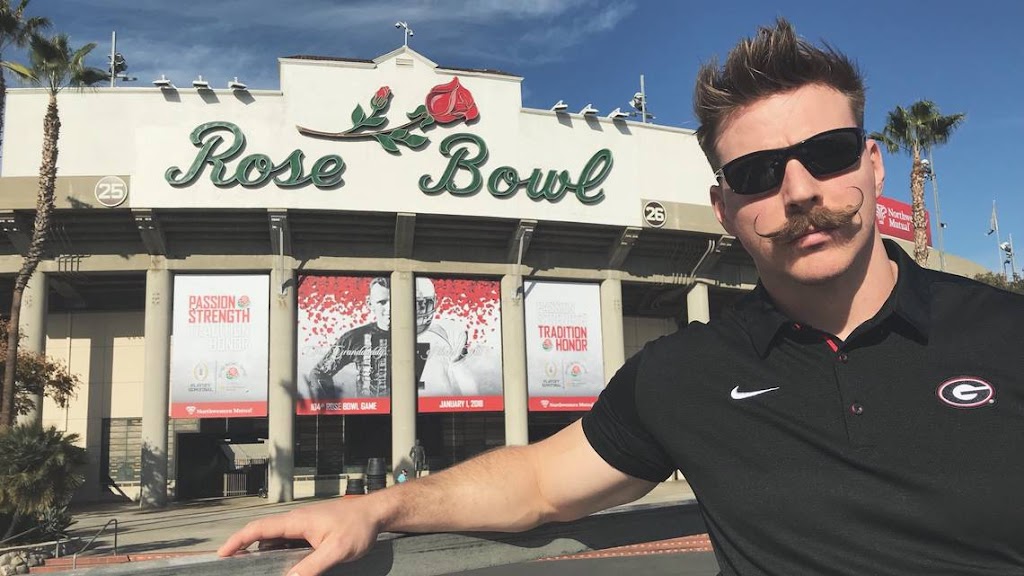BACKGROUND
Aaron Feld was hired by the Ducks as their next head football strength and conditioning coach this week. While people love to talk about the inane little things – like how he wears a mustache – it is his qualifications as a strength professional which set him apart.
His resume is easy to look up; former Director of Strength and Conditioning for all 13 sports at the University of North Alabama; assistant at the University of Alabama-Birmingham (UAB) and a volunteer coach under Scott Cochran at Alabama for a season in 2014. He played at Mississippi State as a long snapper and had a ‘cup of coffee’ in training camp with the Tampa Bay Buccaneers in 2011.
His qualifications go deeper having now worked with Scott Sinclair for two seasons at Georgia. Sinclair, for those that do not know, worked at Marshall from 2013-15; working alongside one of Mario Cristobal’s most trusted friends Alex Mirabal. That is just how intertwined Cristobal, Alabama and Feld are. Cristobal worked with Feld at Alabama for one season; he got plenty of insight about Sinclair from Mirabal and enough information to trust Sinclair’s assessment of Feld.
Aside from that, Feld meets a different level of criteria which had not been met by Irele Oderinde – he has an advanced degree in clinical and exercise science from Mississippi State and certifications from far better organizations with a certification of Certified Strength and Conditioning Specialist (CSCS) by the National Strength and Conditioning Association and holds a SCCC certification from the Collegiate Strength and Conditioning Coaches Association.
To break that down, the SCCC certification program (Strength and Conditioning Coach Certified) was granted by the NCAA on February 18, 2014, for demonstrating compliance with the rigorous NCCA Standards for the Accreditation of Certification Programs. The NCAA Standards were created in 1977 and updated in 2003 to ensure certification programs adhere to current standards of practice for the certification industry. NCCA standards were recently updated again to provide even greater rigor in the evaluation of certification programs.
The certification from the NSCA is considered the ‘gold standard’ for strength coaches as well. His former boss is one of the distinguished few (relatively speaking) who have received a master strength and conditioning coach certification by the CSCCA. You know who else has that distinction? Jim Radcliffe.
This is all important because it sets Feld apart – he is not just a ‘gym teacher’ who is strong, he has a breadth of knowledge about the science behind movement. I harped on this last year because it was very clear to me that Willie Taggart’s chosen strength coach simply did not have the right understanding of the human body to be a head strength coach at a Power Five football program.
SETTING NEW STANDARDS
It was easy to say that the three players who were hospitalized last year were either ‘soft’ or were ‘out of shape’ or were ‘trying to impress their team mates and new coach’; but it was also an inaccurate representation of what occurred.
To put it in perspective, during the 2017 football season, Georgia lost one player to major injury. One. Oregon had three players hospitalized due to a workout. Think about that for a moment; three players were hospitalized due to a workout while Georgia, playing in the SEC, suffered just one major injury.
That is a different standard. While there is clearly some luck involved in having no major injuries, there are also some design elements to going an entire season with so few injuries. (In 15 games, not once did an offensive lineman get rolled up from behind; not once in 15 games did a running back make a plant and cut back; or get his ankle rolled in a scrum; not once did a receiver get horse collar tackled; not once did an opponent get a targeting penalty that was severe enough to knock a player out of multiple games; that is luck.)
The design element, though, is something which Cristobal is eager to tap into. When I was lifting, I went 20 years without a major shoulder injury – and I was lifting pretty heavy. The strange part – I never ‘stretched’ in the traditional sense. You would never catch me doing static stretching; even back in the 90’s when most were still doing it. Instead I did dynamic warmup work. Some with light weights, some with simple movements.
When I saw Adam Archuleta, former linebacker at Arizona State, working out with some unique techniques (drop pushups, catching a weighted bar, etc), I implanted these concepts into my own workouts. I recognized the importance of this as its own form of ‘plyometrics’ for the chest muscles.
Fast forward and hear of Cristobal’s statement last week when talking about what he wants from the new strength program: “The ability to bend, to strike, to roll hips, to accelerate, decelerate, change direction, play with balance and body control, those are movements that have to be practiced,” Cristobal said. “Everything you do in that weight room has to mimic what a true game situation is like. I’m a big believer in making sure everything we do relates to playing better, to improving performance. Not looking for beach muscles, for any of that. It’s a very different program, and it’s a program that has stood the test of time.” (Courtesy OregonLive)
This statement reflects the philosophy that athletics is about more than just being bigger or stronger; being the best requires more than size.
When I was at South Dakota, one of the things I learned was the importance of deceleration. Everyone works on acceleration frequently, but how often do we work on deceleration? That is one of the areas in which injuries often occur; as we slow-down from a sprint, muscles, tendons and ligaments can become susceptible to injury in a way we don’t ever even imagine; so we worked with our athletes during the offseason on very specific deceleration drills. This is similar in concept to what Archuleta did with ‘catching’ a weighted bar.
These are also some of the concepts Feld will bring with him. He understands the biomechanics of movement and how to implement those techniques to maximize the overall performance of football players while minimizing the long-term negative potential impact via injuries.
Something else he brings? Credibility. It is not enough, sometimes, to just ‘know’ what to do and instruct others. Feld is going to bring with him some version of ‘Throwdown Thursday’s’ to the Oregon football program. In essence, this was a weekly session with the strength and conditioning staff performing different feats of strength. Feld was maniacal and the leader of the group in many of the challenges.
Many people will remember seeing video of Jim Radcliffe running with (and out-running most) Oregon football players in the past. Add in a coach who shows that strength and conditioning is more than just a required part of football, but a lifestyle that shows dedication and you have Aaron Feld.
One of the things I loved about South Dakota is that I worked out in the same gym as the players. When we were done for the day (I worked with all teams, so normally my day wasn’t done until 4PM); I would change into my own lifting gear and start my workouts. Everything I taught, I did; and everything I did was witnessed by my athletes. At the very least, I know that they respected I had put in the work over many years and that the techniques and concepts were solid.
Most importantly, Feld, who has worked with two of the very best in the SEC (Sinclair and Cochran), is excited to work with a legend in the business. While many love to hate Radcliffe, his knowledge is extensive and he is one of the pioneers in the field. His contributions to the sport are so vast and immense it would be impossible to list them; think of him as the Bill Walsh of strength coaching – plyometrics are to Radcliffe as the West Coast offense is to Walsh.
Taggart discarded that because he cared very little for substance and very much for style. Oderinde was ‘big and strong’ and he wanted his players to be ‘big and strong’ without thinking (or knowing) that football is a sport where big and strong is only a part of the equation.
I think the decision to re-involve Radcliffe is more than just a ‘nice touch’ it takes a young man who played football at Mississippi State and has learned from some of the very best in the business and gives him another level of knowledge from which to draw.
If Cristobal wants to change the way Oregon approaches the offseason as he says he does, he needs someone like Feld to pave the way to the future; a coach who is more than just a ‘cheerleader’ in the weight room and more than just a ‘lunk with a degree.’
Don’t let all of the stupid “stache hype” fool you; Feld is a driven coach with the kind of background which will help establish him as a fixture in the program. Working with Radcliffe will allow the Oregon legend to ‘pass the torch’ to the next generation.
Feld will bring a certain relatability to the workouts and he will bring a passion and energy to what he is trying to do – which is develop young men into their fullest potential. Former players love him and say that he is one of those guys that really brings energy into the room. As one player said “He’s the guy that gets you going at 6 in the morning and really makes you enjoy working out.”
POTENTIAL ISSUES?
It is always wise to look toward a coach’s past to see if there are any potential red flags. None really come up with Feld. His (now) former boss, Sinclair, was at UCF when a player died during an off-season workout. It was later learned that the player tested positive for sickle cell trait. None of the strength and conditioning staff were aware of this fact – which is an important piece of information when designing workout regimens and understanding potential physiological responses to workouts.
The university was found to have liability in the players death and was originally ordered to pay the family $10 million (an award which was later reduced to $200,000 due to liability limitations of state agencies).
What does this have to do with Feld? Really not much, but he recently sent a tweet that essentially ‘poo-pooed’ the concept of studies and their findings. While it is true that often surveys and studies ‘prove what their author set out to prove’ (as he tweeted), it is also true that there is plenty of science behind those studies. While the results should be looked at with some skepticism as to the intent of the author, the science behind the results should never be dismissed.
It will be important with the ‘next step’ in his career that he look deeper than workout routines; deeper than simple biomechanics. He will need to have a deep understanding of how some genetic factors can affect the overall health and well-being of his athletes.
That will not be his job to do the research, that job will belong to Andrew Murray still, but he will need to listen. He will need to accept that ‘studies’ are a crucial aspect of program design. Murray and Radcliffe are a wealthy resource on which he will need to lean if he wants to continue his evolution. Remember, it is about more than just getting big and strong.
PEER REVIEWS
So far, his peers and others in the business have provided nothing but glowing reviews of his work as a strength coach. While he is known now as Georgia’s ‘assistant’ strength coach, he has directed a Division I level program prior and has put together workouts for both men and women.
He has worked across multiple sports and knows that each player, each position, each responsibility will have a different need in the gym. He is not a big ‘boot camp’ break-them-down coach. He is not interested in proving that he knows what he is doing; he just does what is best for the athletes.
The Throwdown Thursday videos were a wild hit with fans, but peers also thought it was a unique way for the staff at Georgia to implement their program beyond the hidden measures of a weight room; it was a unique way to take the ‘process’ of athletic improvement and show it to the world. Some of it is showmanship, something of which I am not a huge fan. As a strength coach, I didn’t really want anyone to know me, my methods or my thought processes; I just wanted to teach others.
But that is also just simply a part of my own personality; to expect others to have a similar personality would be unfair. The truth is young players want to know that they will be doing something they enjoy. Workouts are difficult; but seeing that the staff are actively involved with strength training sends a message to recruits and current players alike. It also gets the fan base engaged with the people most important to a football program’s growth. Strength coaches spend more one-on-one time with athletes than anyone on campus. Those are the relationships that will matter over the long course of a player’s development.
The reality that Feld is A) a former player and B) a relatable strength athlete will go a long way to establishing a level of credibility that is deeper than he is ‘big and strong.’ So if you know Aaron Feld because of the mustache; or like him because he is ‘jacked’ then get to know why he is a good hire.
Neither of those things matter.
What matters will be how he translates his knowledge both learned and applied, to the weight room and how those translate to success on the football field.


